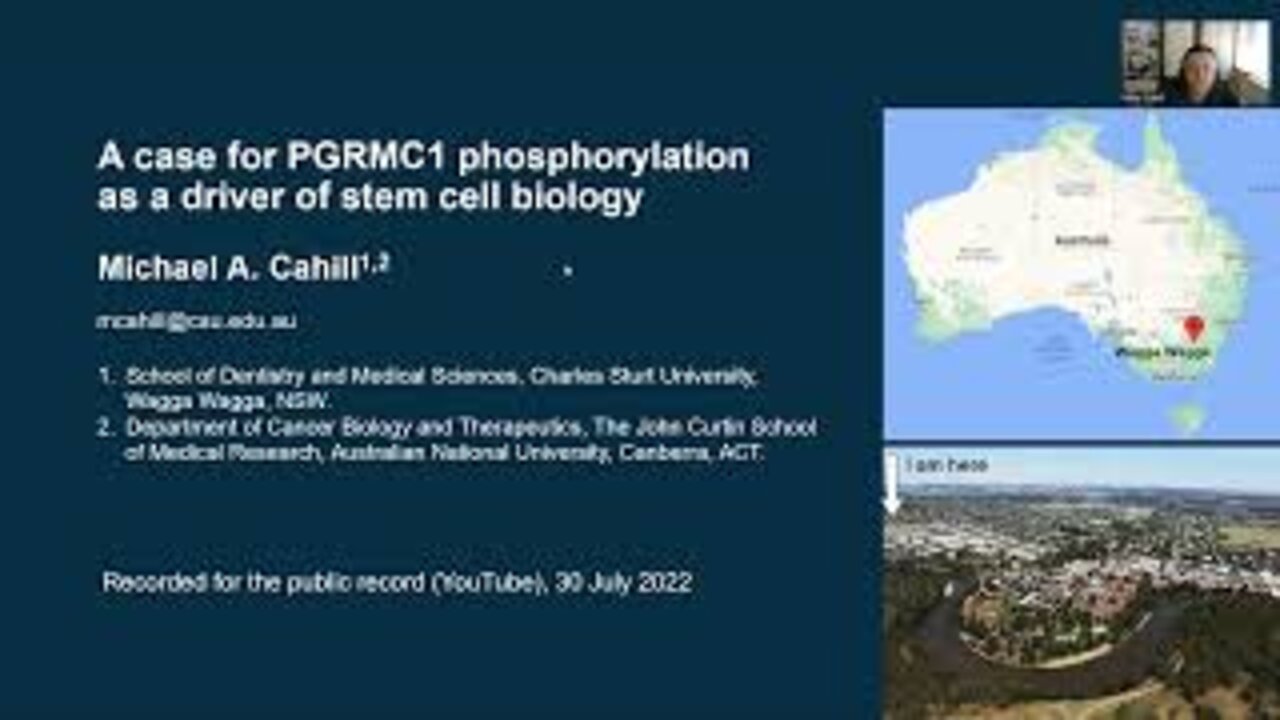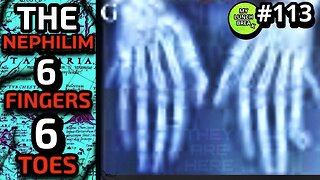Premium Only Content

A case for PGRMC1 phosphorylation as a driver of stem cell biology
0:00 Introduction
0:00:44 Background
0:03:58 How I became involved (Germany, 2000-2007)
0:05:55 PGRMC1 phosphorylation in breast cancer
0:10:28 PGRMC1 induced before Hif-1-dependent hypoxia
0:14:23 A model for PGRMC1 phosphorylation
0:16:56 PGRMC1 affects cell survival to peroxide
0:20:32 2008 relocation to a regional Australian university: no national grant support
0:21:58 In my own interest: the following story is unique
0:22:17 Lack of Australian grant funding to me has retarded world science
0:23:07 I am available for strategic recruitment
0:23:27 PGRMC1 gained novel functions in the last eumetazoan common ancestor (LEUMCA)
0:24:24 The LEUMCA developed the first gastrulation organizer and novel cell types
0:28:33 PGRMC gained a new C-terminus and phosphorylated tyrosines with the LEUMCA
0:31:01 Y139 was inserted into the MAPR interhelical insertion region (MIHIR)
0:33:38 Y180 is part of the novel LEUMCA C-terminus
0:34:45 Y139 is present in a conserved putative amphiphilic helix
0:36:23 The MIHIR resembles a motif from multiple myosins
0:37:29 The MIHIR helix region has predicted coiled-coil propensity
0:38:14 In myosins the motif is in the coiled-coil region
0:39:19 Therefore PGRMC1 and myosins may interact with overlapping proteins
0:40:22 The MIHIR was inserted between heme interacting residues
0:41:43 Eumetazoan Y139 phosphorylation would prevent coiled-coils and recruit SH2 proteins
0:42:34 Eumetazoan Y180 phosphorylation would recruit SH2 domain proteins
0:43:22 Y139 is on the surface in the crystal structure
0:44:38 Proteins bound to PGRMC1 signal motifs could interact with each other
0:45:47 The MIHIR is not helical in the crystal structure
0:48:14 Protein binding to PGRMC1 could lead to signal activation
0:49:08 Mutation of Y180 module in cell culture (experiment design)
0:51:05 PGRMC1 phosphorylation mutants induce altered morphology
0:52:37 Proteomics on cell lines
0:53:15 Pathways analyses predict effects on metabolism and function
0:55:26 Verification of selected pathway differences
0:57:54 Proteomics conclusion of large effects on cells
0:58:14 PGRMC1 Y180 phosphorylation contributes to cancer growth
0:59:08 NAD homeostasis
1:00:21 PGRMC1 Y180 affects NAD/NNMT homeostatic pathways
1:01:34 PGRMC1 Y180 therefore implicated in aging biology
1:02:42 PGRMC1 implicated in circadian NAD regulation
1:03:43 From the literature both NNMT pathway and PGRMC1 affect stem cell pluripotency
1:04:53 I predict that PGRMC1 phosphorylation drives these effects
1:05:19 Eumetazoan embryology and stem cell biology
1:06:46 Chordates employ genomic CpG genetics during embryology
1:08:18 PGRMC1 is a master CpG epigenetic regulator
1:09:29 The Y180 TM exhibits CpG hypermethylation
1:10:07 Heat map and volcano plot of hypermethylated CpG markers due to Y180 mutation
1:10:54 CpG hypomethylation methylomics predicts that PI3K/Akt activity requires Y180
1:12:03 Pathways of Y180 hypomethylated markers predict stem cell and developmental biology
1:13:12 Hypothetical models of PGRMC1 phosphorylation is stem cells
1:14:47 Proposed PGRMC1 as cause of Alzheimer's disease
1:20:59 Summary
1:21:47 Model for PGRMC1 in eumetazoan embryo and stem cell biology
1:22:07 Collaborators and thanks to Ewa Goldys
This 80 minute talk from 30 July 2022 (53 min played 1.5x) is for the public record and features slides I used in a 30 minute keynote talk at the Global Conference on Cell and Stem Cell Research, which I gave yesterday evening my time, on 29th July 2022. I have taken more time to elaborate important points in this talk. I've also supplemented the talk with some slides explaining how I got into this research field, so it takes a little longer.
In the talk I argue that failure of the Australian grant system to support my work upon my return to Australia in 2008, after cofounding a German biotech company where I was Chief Research Officer (ProteoSys AG, 2000-2007), has probably retarded not just my own career. My research could have benefited the entire fields of cancer, stem cell biology, embryology, fertility, and neurobiology, worldwide. There are particular links to some economically important indication areas, including including Alzheimer's disease and possibly aging biology.
I argue that my initial Australian grant proposals in 2009/2010 were rejected primarily because they were submitted from a regional university, despite the fact that I could have executed them, and they would have been spectacularly successful as the results I describe in this talk amply demonstrate. Once initial support is not given, the vicious cycle sets in as publication track record levels off due to lack of research funding. In my opinion, the intellectual property I brought with me from Germany to Australia in 2008 could have generated a substantial contribution to the Australian economy. That opportunity was squandered because of the failure of the Australian grant funding system to be able to recognise and support viable important research.
-
 10:42:19
10:42:19
Reolock
17 hours agoWoW Classic Hardcore (LVL 60) | RAID DAY | Rumble FIRST HC Raid
76.4K4 -
 3:10:03
3:10:03
Barry Cunningham
15 hours agoTRUMP WEEKEND BRIEFING! MORE WINNING...MORE LEFTIES LOSING IT!
57.9K38 -
 2:20:09
2:20:09
Tundra Tactical
14 hours ago $2.86 earnedIs Trumps Executive Order A Second Amendment Wishlist???: The Worlds Okayest Gun Live Stream
38.9K2 -
 2:33:51
2:33:51
John Crump Live
19 hours ago $25.52 earnedSaturday Night Main Event!
124K13 -
 13:57
13:57
TimcastIRL
1 day agoTrump NUKES IRS After DOGE Investigation, OVER 9000 Employees To Be FIRED
134K179 -
 13:35
13:35
Russell Brand
18 hours agoPFIZER JUST MADE THEIR NEXT MOVE AND EXPERTS ARE TERRIFIED
157K320 -
 1:15:57
1:15:57
Victor Davis Hanson Show
1 day agoOver Here, Over There: the Russo-Japanese War and Trumpian Peace Policy
75.9K35 -
 23:55
23:55
MYLUNCHBREAK CHANNEL PAGE
1 day agoThe Nephilim Are Here
100K100 -
 1:00:58
1:00:58
Break The Cycle w/ Joshua Smith
15 hours ago $2.01 earnedBreak The Cycle Ep. 247: Funny Guys w/ Robbie "The Fire" Bernstein
33.1K1 -
 41:26
41:26
TheTapeLibrary
1 day ago $10.42 earnedThe Disturbing Horrors of the Trans-Allegheny Lunatic Asylum
64.2K13